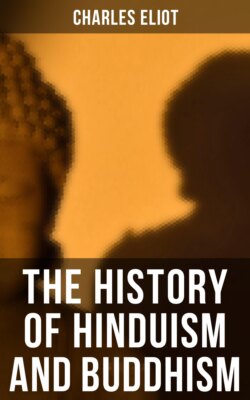Читать книгу The History of Hinduism and Buddhism - Charles Eliot - Страница 46
На сайте Литреса книга снята с продажи.
1
ОглавлениеAs sacrifice and ceremonial are the material accompaniments of prayer, so are asceticism and discipline those of thought. This is less conspicuous in other countries, but in India it is habitually assumed that the study of what we call metaphysics or theology needs some kind of physical discipline and it will be well to elucidate this point before describing the beginnings of speculation.
Tapas, that is asceticism or self-mortification, holds in the religious thought and practice of India as large a place as sacrifice. We hear of it as early, for it is mentioned in the Rig Veda[163], and it lasts longer, for it is a part of contemporary Hinduism just as much as prayer or worship. It appears even in creeds which disavow it theoretically, e.g. in Buddhism, and evidently has its root in a deep-seated and persistent instinct.
Tapas is often translated penance but the idea of mortification as an expiation for sins committed, though not unknown in India, is certainly not that which underlies the austerities of most ascetics. The word means literally heat, hence pain or toil, and some think that its origin should be sought in practices which produced fever, or tended to concentrate heat in the body. One object of Tapas is to obtain abnormal powers by the suppression of desires or the endurance of voluntary tortures. There is an element of truth in this aspiration. Temperance, chastity and mental concentration are great aids for increasing the force of thought and will. The Hindu believes that intensity and perseverance in this road of abstinence and rapture will yield correspondingly increased results. The many singular phenomena connected with Indian asceticism have been imperfectly investigated but a psychological examination would probably find that subjective results (such as visions and the feeling of flying through the air) are really produced by the discipline recommended and there may be elements of much greater value in the various systems of meditation. But this is only the beginning of Tapas. To the idea that the soul when freed from earthly desires is best able to comprehend the divine is superadded another idea, namely that self-mortification is a process of productive labour akin to intellectual toil. Just as the whole world is supposed to be permeated by a mysterious principle which can be known and subdued by the science of the sacrificing priests, so the ascetic is able to control gods and nature by the force of his austerities. The creative deities are said to have produced the world by Tapas, just as they are said to have produced it by sacrifice and Hindu mythology abounds in stories of ascetics who became so mighty that the very gods were alarmed. For instance Râvaṇa, the Demon ruler of Lanka who carried off Sîtâ, had acquired his power by austerities which enabled him to extort a boon from Brahmâ. Thus there need be nothing moral in the object of asceticism or in the use of the power obtained. The epics and dramas frequently portray ascetics as choleric and unamiable characters and modern Yogis maintain the tradition.
Though asceticism resembles the sacrifice in being a means by which man can obtain his wishes whether religious or profane, it differs in being comparatively easy. Irksome as it may be, it demands merely strength of will and not a scientific training in ritual and Vedic texts. Hence in this sphere the supremacy of the Brahman could be challenged by other castes and an instructive legend relates how Râma slew a Śûdra whom he surprised in the act of performing austerities. The lowest castes can by this process acquire a position which makes them equal to the highest[164].
Of the non-Brahmanic sects, the Jains set the highest value on Tapas, but chiefly as a purification of the soul and a means of obtaining an unearthly state of pure knowledge[165]. In theory the Buddha rejected it; he taught a middle way, rejecting alike self-indulgence and self-mortification. But even Pali Buddhism admits such practices as the Dhûtângas and the more extravagant sects, for instance in Tibet, allow monks to entomb themselves in dark cells. According to our standards even the ordinary religious life of both Hindus and Buddhists is severely ascetic. It is assumed as a sine qua non that strict chastity must be observed, nourishment be taken only to support life and not for pleasure, that all gratification coming from the senses must be avoided and the mind kept under rigid discipline. This discipline receives systematic treatment in the Yoga school of philosophy but it is really common to all varieties of Hinduism and Buddhism; all agree that the body must be subdued by physical training before the mind can apprehend the higher truths. The only question is how far asceticism is directly instrumental in giving higher knowledge. If some texts speak slightingly of it, we must remember that the life of a hermit dwelling in the woods without possessions or desires might not be regarded by a Hindu as tapas though we should certainly regard it as asceticism. It is also agreed that supernatural powers can be acquired by special forms of asceticism. These powers are sometimes treated as mere magic and spiritually worthless but their reality is not questioned.
